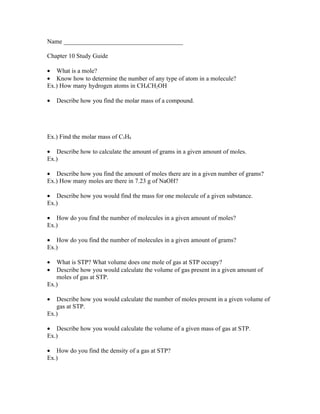Chemistry - Chp 10 - Chemical Quantities - Study Guide
•Transferir como DOC, PDF•
0 gostou•894 visualizações
Denunciar
Compartilhar
Denunciar
Compartilhar

Recomendados
Mais conteúdo relacionado
Mais de Mr. Walajtys
Mais de Mr. Walajtys (20)
Chemistry - Chp 11 - Chemical Reactions - PowerPoint

Chemistry - Chp 11 - Chemical Reactions - PowerPoint
Chemistry - Chp 10 - Chemical Quantities - PowerPoint

Chemistry - Chp 10 - Chemical Quantities - PowerPoint
Chemistry - Chp 7 - Ionic and Metallic Bonding - PowerPoint

Chemistry - Chp 7 - Ionic and Metallic Bonding - PowerPoint
Chemistry - Chp 8 - Covalent Bonding - Study Guide

Chemistry - Chp 8 - Covalent Bonding - Study Guide
Chemistry - Chp 13 - States of Matter - Study Guide

Chemistry - Chp 13 - States of Matter - Study Guide
Chemistry - Chp 3 - Scientific Measurement - Study Guide 

Chemistry - Chp 3 - Scientific Measurement - Study Guide
Chemistry - Chp 14 - The Behavior of Gases - Study Guide

Chemistry - Chp 14 - The Behavior of Gases - Study Guide
Chemistry - Chp 20 - Oxidation Reduction - Study Guide

Chemistry - Chp 20 - Oxidation Reduction - Study Guide
Chemistry- Chp 18 - Reaction Rates and Equilibrium - Study Guide

Chemistry- Chp 18 - Reaction Rates and Equilibrium - Study Guide
Chemistry - Chp 11 - Chemical Reactions - Study Guide

Chemistry - Chp 11 - Chemical Reactions - Study Guide
Chemistry - Chp 7 - Ionic and Metallic Bonding - Study Guide

Chemistry - Chp 7 - Ionic and Metallic Bonding - Study Guide
Chemistry - Chp 6 - The Periodic Table Revisited - Study Guide

Chemistry - Chp 6 - The Periodic Table Revisited - Study Guide
Chemistry - Chp 5 - Electrons in Atoms - Study Guide

Chemistry - Chp 5 - Electrons in Atoms - Study Guide
Chemistry - Periodic Trends - Study Guide Appendix

Chemistry - Periodic Trends - Study Guide Appendix
Último
God is a creative God Gen 1:1. All that He created was “good”, could also be translated “beautiful”. God created man in His own image Gen 1:27. Maths helps us discover the beauty that God has created in His world and, in turn, create beautiful designs to serve and enrich the lives of others.
Explore beautiful and ugly buildings. Mathematics helps us create beautiful d...

Explore beautiful and ugly buildings. Mathematics helps us create beautiful d...christianmathematics
Último (20)
BAG TECHNIQUE Bag technique-a tool making use of public health bag through wh...

BAG TECHNIQUE Bag technique-a tool making use of public health bag through wh...
Z Score,T Score, Percential Rank and Box Plot Graph

Z Score,T Score, Percential Rank and Box Plot Graph
Kisan Call Centre - To harness potential of ICT in Agriculture by answer farm...

Kisan Call Centre - To harness potential of ICT in Agriculture by answer farm...
Explore beautiful and ugly buildings. Mathematics helps us create beautiful d...

Explore beautiful and ugly buildings. Mathematics helps us create beautiful d...
Disha NEET Physics Guide for classes 11 and 12.pdf

Disha NEET Physics Guide for classes 11 and 12.pdf
Measures of Central Tendency: Mean, Median and Mode

Measures of Central Tendency: Mean, Median and Mode
9548086042 for call girls in Indira Nagar with room service

9548086042 for call girls in Indira Nagar with room service
Chemistry - Chp 10 - Chemical Quantities - Study Guide
- 1. Name ______________________________________ Chapter 10 Study Guide • What is a mole? • Know how to determine the number of any type of atom in a molecule? Ex.) How many hydrogen atoms in CH4CH2OH • Describe how you find the molar mass of a compound. Ex.) Find the molar mass of C3H8 • Describe how to calculate the amount of grams in a given amount of moles. Ex.) • Describe how you find the amount of moles there are in a given number of grams? Ex.) How many moles are there in 7.23 g of NaOH? • Describe how you would find the mass for one molecule of a given substance. Ex.) • How do you find the number of molecules in a given amount of moles? Ex.) • How do you find the number of molecules in a given amount of grams? Ex.) • What is STP? What volume does one mole of gas at STP occupy? • Describe how you would calculate the volume of gas present in a given amount of moles of gas at STP. Ex.) • Describe how you would calculate the number of moles present in a given volume of gas at STP. Ex.) • Describe how you would calculate the volume of a given mass of gas at STP. Ex.) • How do you find the density of a gas at STP? Ex.)
- 2. • Describe how you would calculate the percent composition of each component of a compound? Ex.) • What is an empirical formula? Know how to write empirical formulas from molecular formulas if possible. • What is a molecular formula? • Describe how you can calculate the empirical formula of a compound based on its percent composition. Ex.) • Describe how you could calculate the molecular formula based on its empirical formula.